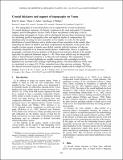Crustal thickness and support of topography on Venus
Author(s)
James, Peter Benjamin; Zuber, Maria; Phillips, Roger J.
DownloadZuber_Crustal thickness.pdf (4.589Mb)
PUBLISHER_POLICY
Publisher Policy
Article is made available in accordance with the publisher's policy and may be subject to US copyright law. Please refer to the publisher's site for terms of use.
Terms of use
Metadata
Show full item recordAbstract
The topography of a terrestrial planet can be supported by several mechanisms: (1) crustal thickness variations, (2) density variations in the crust and mantle, (3) dynamic support, and (4) lithospheric stresses. Each of these mechanisms could play a role in compensating topography on Venus, and we distinguish between these mechanisms in part by calculating geoid-to-topography ratios and apparent depths of compensation. By simultaneously inverting for mass anomalies at two depths, we solve for the spatial distribution of crustal thickness and a similar map of mass anomalies in the mantle, thus separating the effects of shallow and deep compensation mechanisms on the geoid. The roughly circular regions of mantle mass deficit coincide with the locations of what are commonly interpreted to be buoyant mantle plumes. Additionally, there is a significant geographic correlation between patches of thickened crust and mass deficits in the mantle, especially for spherical harmonic degree l < 40. These mass deficits may be interpreted either as lateral thermal variations or as Mg-rich melt residuum. The magnitudes of mass deficits under the crustal highlands are roughly consistent with a paradigm in which highland crust is produced by melting of upwelling plumes. The mean thickness of the crust is constrained to a range of 8–25 km, somewhat lower than previous estimates. The best two-layered inversion of gravity incorporates a dynamic mantle load at a depth of 250 km.
Date issued
2013-04Department
Massachusetts Institute of Technology. Department of Earth, Atmospheric, and Planetary SciencesJournal
Journal of Geophysical Research: Planets
Publisher
American Geophysical Union
Citation
James, Peter B., Maria T. Zuber, and Roger J. Phillips. “Crustal Thickness and Support of Topography on Venus.” Journal of Geophysical Research: Planets 118, no. 4 (April 2013): 859–875.
Version: Final published version
ISSN
21699097